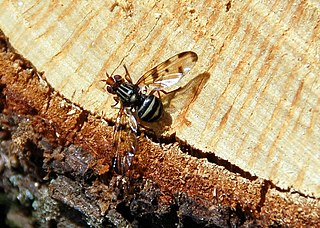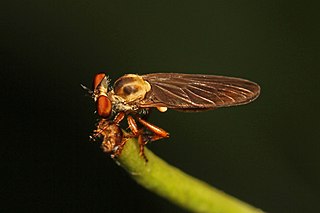
The Ulidiidae or picture-winged flies are a large and diverse cosmopolitan family of flies (Diptera), and as in related families, most species are herbivorous or detritivorous. They are often known as picture-winged flies, along with members of other families in the superfamily Tephritoidea that have patterns of bands or spots on the wings. Some species share with the Tephritidae an unusual elongated posteroapical projection of the anal cell in the wing, but can be differentiated by the smoothly curving subcostal vein. Two species, Tetanops myopaeformis and Euxesta stigmatias, are agricultural pests.

The Micropezidae are a moderate-sized family of acalyptrate muscoid flies in the insect order Diptera, comprising about 500 species in about 50 genera and five subfamilies worldwide,. They are most diverse in tropical and subtropical habitats, especially in the Neotropical Region.

The Richardiidae are a family of Diptera in the superfamily Tephritoidea.

Ochthera is a genus of flies in the family of shore flies (Ephydridae). The genus is distinctive because of the swollen raptorial forelegs. The larvae are predaceous on midge larvae while the adults feed on midges and mosquitoes. The genus is found around the world with about 37 species. The species Ochthera chalybescens has been shown to prey on African malaria vectors.

Otitinae is the name of a subfamily of flies in the family Ulidiidae. It was formerly the Otitidae. Like the Ulidiinae, most species are herbivorous or saprophagous. Most species share with the Tephritidae an unusual elongated projection of the anal cell in the wing, but can be differentiated by the smoothly curving subcostal vein. Most are dull gray to shiny brown or black flies with vein R1 setulose or, in a few cases, bare.

Platystomatinae is a subfamily of flies (Diptera) in the family Platystomatidae that includes 80 genera, the largest subfamily with at last estimate, c. 900 species globally.

Rainieria is a genus of stilt-legged flies in the family Micropezidae. There are at least 20 described species in Rainieria.

Chloropinae is a subfamily of grass flies in the family Chloropidae.

Holcocephala is a genus of robber flies in the family Asilidae. There are at least 40 described species in Holcocephala.

Holopogon is a genus of robber flies in the family Asilidae. There are at least 60 described species in Holopogon.

Geomyza is a genus of flies in the family Opomyzidae. There are at least 30 described species in Geomyza.

Thevenetimyia is a genus of bee flies, insects in the family Bombyliidae. There are at least 40 described species in Thevenetimyia.
Athyroglossa is a genus of shore flies in the family Ephydridae.

Senopterina is a genus of signal flies. There are about 17 described species in Senopterina.
Odontomera is a genus of flies in the family Richardiidae. There are about 19 described species in Odontomera.














